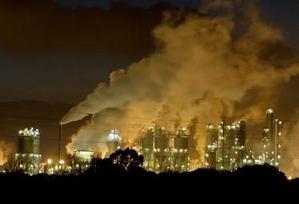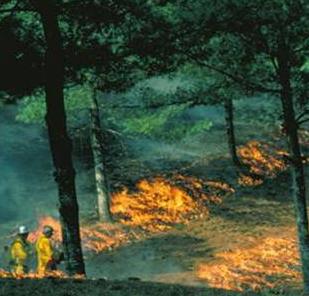Surface temperature increases are projected to increase 1.8-6.3 °F in the next century, with scientists' best guess being about 3.5 °F. Scientific modeling suggests that the surface temperature will continue to increase beyond the year 2100 even if concentrations of greenhouse gases are stabilized by that time. However, if carbon dioxide emissions continue to increase at present rates, a quadrupling of pre-industrial CO2 concentration will occur not long after the year 2100. Projected temperature increases for such an atmospheric concentration are 15-20 °F above the present day mean annual global surface temperature.
Sea Level Rise
Increasing global temperatures causes the thermal expansion of sea water and the melting of icecaps which will result in rising sea level. Sea level has risen 4 to 10 inches this century and is predicted to rise another 6 to 37 inches in the next century. A doubling of pre-industrial CO2 concentration (550 ppm) is predicted to result in a sea level rise of greater than 40 inches. A sea level rise of 80 inches is projected for an atmospheric CO2 concentration of 1100 ppm, a quadrupling of pre-industrial levels. Sea level rise increases the vulnerability of coastal populations to flooding and causes land to be lost to erosion. There are currently 46 million people around the world who are at risk due to flooding from storm surges. With a 50 cm sea level rise (approx. one and ½ feet), that number will increase to 92 million. Raise sea level 1 meter (about 3 feet) and the number of vulnerable people becomes 118 million. A 1 meter increase in sea level will be enough to flood 1% of Egypt, 6% of the Netherlands, 17.5% of Bangladesh, and 80% of the Majuro Atoll in the Marshall Islands. Rising waters might force the occupants of numerous small island nations to migrate elsewhere, as many of them lack the coastal defense systems to cope with higher water levels.
Intensification of the Hydrologic Cycle
Warming will likely result in an increase in the amount of water exchanged among the oceans, atmosphere, and land. Increasing rates of evaporation will likely result in drier soils. An accelerated hydrologic cycle means greater amounts of precipitation in some areas and will probably result in more frequent and severe droughts and floods. This prediction has rung true already. In the early '90's, two 100-year floods occurred in less than 5 years in the Midwestern United States. Significant changes in water volume, distribution, and supply are predicted and will likely have a dramatic impact on regional water resources.
Health Effects
A warming earth will most likely have a spectrum of largely negative impacts on human health. The predicted decrease in the difference between day and night temperatures will result in more thermal extremes. Therefore, an increase in mortality from heat stress is likely (e.g. 465 deaths in Chicago during the summer of 1995). As a result of warming, the area of the earth's surface experiencing "killing" frosts will probably decline. As a result, there will likely be an increase in the geographical range of vector-borne (e.g. mosquito carried) diseases such as malaria, dengue, yellow fever, and encephalitis. Currently, 45% of the world's population is within the zone of potential malaria transmission. With predicted temperature increases, there will likely be an additional 50 to 80 million cases of malaria worldwide, bringing the percentage of the world's people within the susceptible zone to 60%.
It is also likely that increasing temperatures will result in a decline in air quality due to increases in the abundance of air pollutants, pollen, and mold spores. An increase in the number of cases of respiratory disease, asthma, and allergies is likely to follow. The change in the frequency and intensity of extreme weather events (e.g. floods and droughts) combined with warmer atmospheric temperatures, will probably result in a host of adverse health effects, among them, exposure to contaminated water supplies and death from diseases.
Dramatic Effects on Ecosystems
Both plant and animal species are sensitive to climate. Due to global warming, ideal temperature and precipitation ranges suitable for present life forms may shift dramatically and rapidly, more rapidly than the species that depend upon them can adapt to naturally. A decline in biodiversity and in the goods and services provided by most ecosystems is a likely result. However, a lengthening of the growing season is also predicted for some high latitude regions. Which means that these regions will likely experience an increase in potential for agricultural production.
Forests
Within the next 100 years many forest species may be forced to migrate between 100 and 340 miles in the direction of the poles. The upper end of this range is a distance typically covered by migrating forests in millennia, not in decades. A decline in species composition is predicted and some forest types may disappear from the earth, while new ones may be established.
Rangelands
Changes in growing seasons and shifts in the boundaries between grasslands, forests, and shrublands are projected results of changing temperature and precipitation regimes. Increased levels of carbon dioxide in the atmosphere may result in a decline in food values of grasses for herbivores.
Deserts
Desert regions are likely to be more extreme, becoming even hotter than they are presently. The process of desertification will be more likely to become irreversible due to drier soils and land degradation through erosion and compaction.
Cryosphere
In the next 100 years between one third and one half of the world's mountain glaciers could melt, affecting the water supply to rivers and thus hydroelectric dams and agriculture. As is already being observed in Alaska, the areal extent and depth of permafrost are projected to decline, resulting in adverse effects on human infrastructure. A decrease in the extent and thickness of sea-ice will likely improve the navigability of the Arctic Ocean.
Mountain Regions
Warming temperatures will probably induce a shift in the distribution of vegetation to higher elevations. Living creatures that exist only at high elevations will possibly become extinct due to the disappearance of habitat or the decline in migration potential. Recreational industries (e.g. ski industry) are likely to be disrupted, having a severe adverse effect on the economies of some regions. The high elevation populations of developing nations will probably suffer from a decline in the abundance of food and fuel.
Lakes, Streams, Wetlands
Climate change is predicted to alter water temperatures, flow regimes, and levels. Such changes will likely cause an increase in biological productivity at high latitudes, but may result in extinctions for low latitude, cool and cold water species. Increased variability in flow, which will result if the frequency and duration of large floods and droughts increases, will tend to reduce water quality, biological productivity, and the habitat in streams.
Coastal Systems
Climate change and sea level rise, or changes in storms or storm surges could cause the erosion of shores and associated habitat, an increase in the salinity of estuaries and freshwater aquifers, a change in tidal ranges in rivers and bays, a change in sediment and nutrient transport, a change in the pattern of chemical and microbiological contamination in coastal areas, and an increase in coastal flooding. The ecosystems at risk are salt water marshes, mangrove ecosystems, coastal wetlands, coral reefs, coral atolls, and river deltas.
Oceans
Changing atmospheric temperatures will change patterns of ocean circulation, vertical mixing, wave climate, and quantities of sea-ice cover. These changes will affect nutrient availability, biological productivity, and the structure and function of marine ecosystems. Paleoclimate (past climate) data and models show that major changes in ocean circulation can be caused by freshwater additions to the oceans from the movement and melting of sea ice or ice sheets and can result in rapid and dramatic changes in climate. Abrupt shifts in climate have had adverse effects on human civilizations in the past. Paleoclimate data suggest that the collapse of the Mesopotamian Empire about 4,200 years ago (2,200 BC) corresponds to a sharp cooling event (Alley & deMenocal, 1998).
Fisheries
Rising temperatures are not predicted to change the global average production; however, significant regional changes are likely. Production is projected to increase in high latitudes, in freshwater and from aquaculture. Warmer climates should increase the growing season, decrease natural winter variability, and improve growing rates in high latitude regions. However, these beneficial results may be counterbalanced by changes in reproductive patterns, migration routes, and ecosystem relationships.
|
Food Production
Total global food production is not expected to change substantially as a result of climate change, but production will probably change dramatically regionally. Some areas will have increasing crop yields.
Others will decline, especially in tropical and subtropical regions. The flexibility in crop distribution (the variety of crops that can be grown in a region) is predicted to decline. Developed countries may be able to adapt to these circumstances. Developing countries that currently struggle with these issues will suffer even more. Source: www.whrc.org |
GLOBAL WARMING
Global warming is an increase in the average temperature of Earth's surface. Since the late 1800's, the global average temperature has increased about 0.7 to 1.4 °F (0.4 to 0.8 °C). Many experts estimate that the average temperature will rise an additional 2.5 to 10.4 °F (1.4 to 5.8 °C) by 2100. That rate of increase would be much larger than most rates of past increases.
Scientists worry that human societies and natural ecosystems might not adapt to rapid climate changes. An ecosystem consists of the living organisms and physical environment in a particular area. Global warming could cause much harm, so countries throughout the world have drafted an agreement to limit it. However, that agreement, known as the Kyoto Protocol, has not yet been ratified (formally approved).
Causes of global warming
Climatologists (scientists who study climate) have analyzed the global warming that has occurred since the late 1800's. A majority of climatologists have concluded that human activities are responsible for most of the warming. Human activities contribute to global warming by enhancing Earth's natural greenhouse effect. The greenhouse effect warms Earth's surface through a complex process involving sunlight, gases, and particles in the atmosphere. Gases that trap heat in the atmosphere are known as greenhouse gases.
The main human activities that contribute to global warming are the burning of fossil fuels (coal, oil, and natural gas) and the clearing of land. Most of the burning occurs in automobiles, in factories, and in electric power plants that provide energy for houses and office buildings. The burning of fossil fuels creates carbon dioxide, whose chemical formula is CO2. CO2 is a greenhouse gas that slows the escape of heat into space. Trees and other plants remove CO2 from the air during photosynthesis, the process they use to produce food. The clearing of land contributes to the buildup of CO2 by reducing the rate at which the gas is removed from the atmosphere or by decomposition of dead vegetation.
A small number of scientists argue that the increase in greenhouse gases has not made a measurable difference in the temperature. They say that natural processes could have caused global warming. Those processes include increases in the energy emitted (given off) by the sun. But the vast majority of climatologists believe that increases in the sun's energy have contributed only slightly to recent warming.
| |
|
 |
 |

